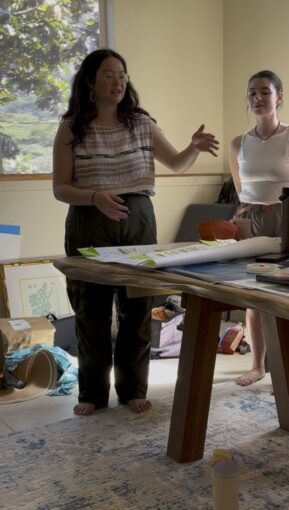By Kaitlyn Gee, PhD Candidate at Massachusetts Institute of Technology
To me, the Native Hawaiian sovereignty movement often feels like a house at dusk. The lights are on in the dining room, and everyone is gathered around a table sharing a meal. They’re family, and the aloha they share between them is palpable. It’s not always happy – sometimes they look tired, sometimes they don’t always see eye to eye – but undeniably they share a bond between them. As a diasporic kanaka born and raised on the mainland, I often find myself on the sidewalk outside, peering in, wondering if I should knock on the door and ask if I’m welcome. Usually I hesitate, worrying that my presence might make them feel less comfortable, or that they need this space to fully let down, or that I shouldn’t come inside empty-handed. Even as I continue to do the work of understanding my mo‘okūʻauhau, learning ‘Ōlelo Hawai‘i, and educating myself politically on Hawaiian history, I often still feel this way.
A little less than a year ago, when I was getting to know the Nation of Hawai‘i, I came in with these hesitations. I hold so much respect for the leaders of the Nation, especially Uncle Bumpy and Brandon, who truly give so much to the movement and the good of the Nation. Who was I, as someone born and raised outside of Hawai‘i, with such tenuous tethers to culture and the land, working as an academic and largely an outsider to the community, to come in and try to contribute?
But, in talking with them and understanding their vision, I began to feel rooted in something bigger. The Nation’s vision of sovereignty is not just for Native Hawaiians – it’s for all of us. Surely they center and work for the well-being of kanaka, as they absolutely should, but doing so benefits us all. They taught me that in order to restore ahupua‘a or lo‘i, or to build a sovereign nation, we have to think bigger. In order for us to reach sovereignty in our lifetime, we need everyone involved. Uncle Bumpy and Brandon showed me that there’s a place for me, and for everyone who believes in a sovereign Hawai‘i. Their leadership style says: come join us. We’ll find a way for you to contribute.
As both a reconnecting kanaka and one raised in the diaspora, there was something grounding about this approach. In the same way that the Nation aims to restore the ahupua‘a system, both on the ‘aina itself and in the governance of the Nation, I started to reflect on my own inner ahupua‘a of kōkua.

Where did my hesitancy to get involved come from, and how could I unblock those challenges to restore my ability to help? How could I re-direct the aloha I feel towards ka lāhui ʻōiwi into tangible actions? Seeing how the Nation involves other kanaka in the diaspora and our allies across the world reminded me that it’s in the showing up, building pilina, and continually re-tethering myself to something bigger that I can make a difference.
I was incredibly excited to learn that the Nation of Hawai‘i is launching the Kī to World Peace initiative this year. This initiative will give everyone, but especially kanaka in the diaspora, an opportunity to connect with the Nation and their journey of restoring sovereignty. Through sponsoring the planting of ti leaf on the Nation, you become tethered to the Nation, to the land and to the community. This connection is physical, and importantly, it becomes a living thing. It’s a conscious effort, for you to intentionally step into relationality with the Nation, and for the Nation to step into relationality with you. In essence, it’s opening the door to the house, beckoning you inside to help. Once the ti leaf is planted, you have a connection to the ʻāina and the Nation that you can begin to nurture.
In closing, the Nation, and especially Uncle Bump and Brandon, has taught me that sovereignty is tangible and it’s here. It’s about getting a land base, building a nation, establishing governance structures and infrastructure, and reconnecting our people to our land and our ways of doing. It’s not a house with a single dining room; it’s a village in Waimānalo and I’ve been there. In the same way that being diasporic means I’m trying to return to a family I’ve never met before, and an ʻāina I am forever getting to know, the Nation channels a reality that they haven’t lived in fully yet. Sovereignty is possible within our lifetime, but that reality – where Kanaka ʻŌiwi make their own decisions about our and how we live – requires all of us to be working together. This journey back to ea is multifaceted – it’s restoring the land and the ahupua‘a model, believing in the power of our ways of doing and the wisdom of our kūpuna watching over us, and for those of us still reconnecting, it’s coming home (virtually and physically) to lend our help. To those of you in the diaspora reading this, I’ll say – the door is very much open. Come inside, and let’s get to work.


0 Comments on "Rooted Again: Reconnection, Responsibility, and the Kī to World Peace"